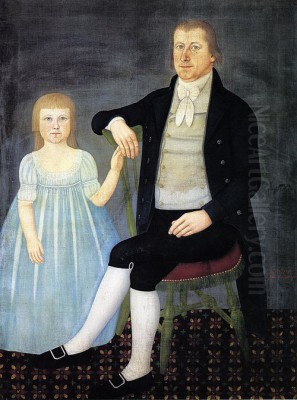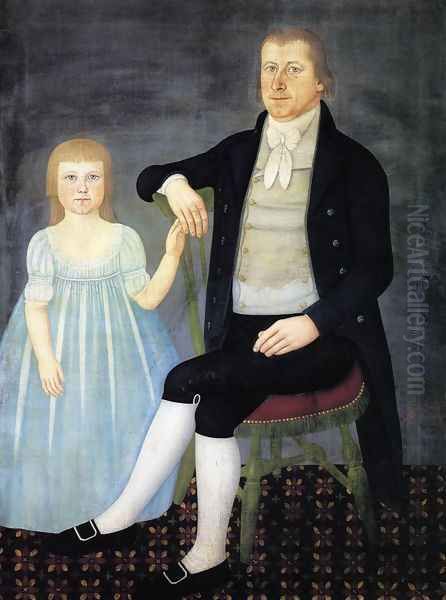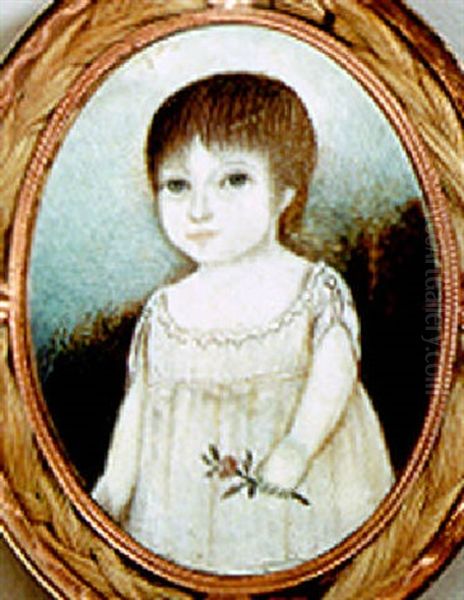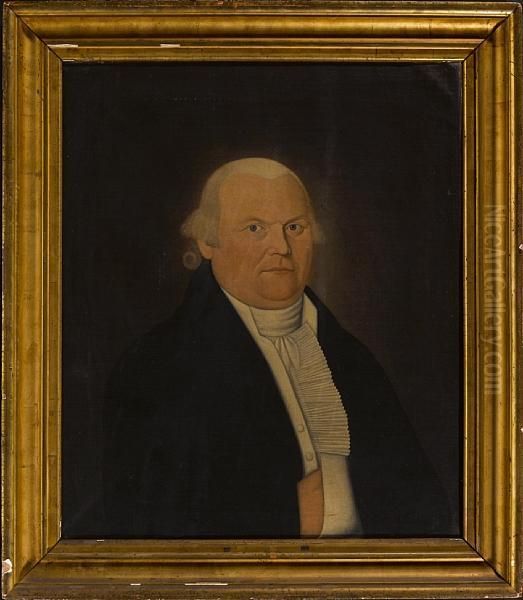
John Brewster Jr. stands as a significant, if sometimes underappreciated, figure in the landscape of early American art. Active from the late 18th century into the mid-19th century, he was a prolific portraitist whose work offers a unique window into the lives and aspirations of New England's burgeoning middle and upper classes. Born with profound deafness, Brewster's life and art are intertwined with the development of deaf education in America and a testament to the power of visual communication. His distinctive style, characterized by a gentle linearity, serene expressions, and an intuitive grasp of character, places him firmly within the tradition of American folk art, yet with a sophistication that often transcends simple categorization.
Early Life and Silent World
John Brewster Jr. was born on May 30th or 31st, 1766, in Hampton, Connecticut. He was the third child of Dr. John Brewster, a respected physician and a member of the Connecticut legislature, and Mary Durfee Brewster. His lineage was notable, tracing back to Elder William Brewster, a prominent figure among the Pilgrims who arrived on the Mayflower, underscoring the family's deep roots in New England's Puritan heritage. This background likely instilled in the young Brewster a sense of tradition and community that would later be reflected in his art.
From birth, John Brewster Jr. was deaf. In an era before standardized sign language or established educational institutions for the deaf, his world was one of silence, and communication would have primarily been through gestures, facial expressions, and written notes. This early and profound reliance on visual cues may well have sharpened his observational skills, a faculty that would prove indispensable in his future career as a portrait painter. Despite the communication challenges, his affluent and supportive family provided him with an education, and his artistic talents were recognized and encouraged.
Artistic Beginnings and Formative Influences

Brewster's initial artistic training is not extensively documented, but it is known that he received some instruction from Joseph Steward, a Dartmouth-educated artist who painted portraits and later founded a museum in Hartford. Steward himself was a competent, if not groundbreaking, painter, and his influence on Brewster might have been more in terms of providing foundational techniques and encouragement rather than shaping a specific stylistic direction.
A more significant early influence appears to have been Ralph Earl (1751-1801), a prominent Connecticut portraitist who had spent time in England and absorbed elements of the British Grand Manner style. Earl returned to America and became known for his ambitious, full-length portraits that often included detailed settings and conveyed the status of his sitters. Brewster's early works, particularly some of his larger-scale portraits from the 1790s, show an awareness of Earl's compositions, his attention to costume, and the somewhat stiff, formal poses characteristic of provincial American portraiture of the time. However, Brewster would soon develop a more personal and intimate style.
Other painters active in New England during this period, whose work Brewster might have encountered, include Winthrop Chandler (1747-1790), known for his direct and somewhat stark likenesses, and Reuben Moulthrop (1763-1814), another Connecticut artist. The artistic environment was one where itinerant painters, or "limners," traveled from town to town, seeking commissions from those who wished to have their likenesses preserved.
The Itinerant Portraitist: A Career Takes Shape
By the 1790s, John Brewster Jr. had embarked on his career as an itinerant portrait painter. This was a common path for artists in early America, where established art centers were few and patronage was dispersed. Brewster traveled throughout Connecticut, Massachusetts, Maine, and eastern New York State, often staying with the families he painted. His deafness, rather than being an insurmountable barrier, may have lent an air of focused intensity to his sittings. Communication would have involved written notes and gestures, fostering a unique, quiet interaction between artist and sitter.
His patrons were typically members of the prosperous merchant class, professionals, and landowners – the backbone of New England society. These individuals sought portraits not just as records of their appearance but also as symbols of their social standing and familial pride. Brewster's advertisements in local newspapers, such as the Columbian Centinel, attest to his professional activities and his desire to reach potential clients. He offered "correct likenesses" and often highlighted his ability to capture the nuances of expression.

During these itinerant years, he began to refine his distinctive style. While the influence of artists like Ralph Earl can be seen in some early compositions, Brewster increasingly moved towards a more simplified and direct approach. He focused on the faces of his sitters, rendering them with a delicate precision and a characteristic serenity.
A Distinctive Artistic Style
John Brewster Jr.'s mature artistic style is readily identifiable. His portraits are marked by a clear, linear quality, with forms often delineated by precise outlines. He employed a palette of soft, often muted colors, with skin tones rendered smoothly, giving his subjects an almost ethereal glow. Backgrounds are typically plain or minimally suggestive of an interior, ensuring that the viewer's attention remains firmly on the sitter. This simplification of setting and emphasis on the human presence is a hallmark of much American folk portraiture.
A key characteristic of Brewster's work is the expressive quality he achieved in the eyes of his subjects. Often large and luminous, they gaze directly at the viewer, creating a sense of immediate connection. This intensity of gaze, coupled with the often placid, subtly smiling mouths, imbues his portraits with a quiet dignity and a gentle, introspective mood. He was particularly adept at capturing the innocence and vulnerability of children, a subject to which he returned throughout his career.
While his technique was rooted in the traditions of European academic art, particularly the British portraiture of the 18th century as exemplified by masters like Sir Joshua Reynolds (1723-1792) and Thomas Gainsborough (1727-1788), Brewster adapted these conventions to his own vision and the tastes of his New England clientele. He eschewed the overt grandeur and elaborate allegories of the Grand Manner, opting instead for a more direct and unpretentious representation that resonated with the democratic spirit of the young republic. His work shares affinities with other American folk artists like Ammi Phillips (1788-1865), whose portraits also feature strong design and compelling gazes, or Erastus Salisbury Field (1805-1900), though Field often ventured into more imaginative and historical subjects.
Brewster's compositions are often balanced and harmonious. Figures are typically presented in three-quarter or half-length views, seated or standing, often holding an attribute – a book, a flower, a piece of fruit, or a tool – that might allude to their age, interests, or social role. These objects are rendered with the same careful attention to detail as the figures themselves, contributing to the overall narrative quality of the paintings.
Focus on Family and Childhood

A significant portion of John Brewster Jr.'s oeuvre is dedicated to portraits of children and family groups. His ability to capture the delicate features and innocent expressions of his young sitters was remarkable. These portraits often convey a sense of tenderness and affection, reflecting the growing emphasis on childhood and domesticity in early 19th-century American culture.
In works depicting children, Brewster often employed soft lighting and a gentle touch, emphasizing their smooth skin and wide, observant eyes. He seemed to possess a unique empathy for his young subjects, perhaps fostered by his own silent world, which may have made him particularly attuned to non-verbal cues and the subtle nuances of expression. His child portraits avoid sentimentality, instead presenting them with a quiet dignity and individuality.
His family portraits, such as James Prince and Son William Henry (1801), demonstrate his skill in arranging multiple figures and conveying familial relationships. These works often highlight the bonds between parents and children, or between siblings, and serve as enduring records of family identity and continuity. The depiction of domestic interiors, though often simplified, adds to the sense of intimacy and personal history. This focus on the family unit was shared by other American artists of the period, including members of the Peale family, such as Charles Willson Peale (1741-1827) and his son Rembrandt Peale (1778-1860), though their styles were generally more academic.
Representative Works: A Closer Look
John Brewster Jr.'s prolific career, spanning over four decades, resulted in more than 250 known portraits. Several key works exemplify his style and thematic concerns:
Comfort Starr Mygatt and His Daughter Lucy (c. 1799): This double portrait showcases Brewster's early skill. The figures are somewhat stiff, reflecting the prevailing style, but the faces are rendered with sensitivity, particularly the direct gaze of the young Lucy. The detailed rendering of costume and the inclusion of a landscape view through a window are characteristic of his earlier, more ambitious compositions influenced by artists like Ralph Earl.
James Prince and Son William Henry (1801): This tender depiction of a father and his young son is a hallmark of Brewster's ability to capture familial affection. The composition is balanced, with the figures closely linked. William Henry's bright, inquisitive gaze is particularly compelling, and the work as a whole exudes a sense of quiet domesticity and paternal pride.
Unidentified Boy with Book (c. 1810): Housed in the Florence Griswold Museum, this portrait is a quintessential example of Brewster's work with children. The boy, with his neatly combed hair and serious expression, holds a book, a common symbol of learning and status. His large, dark eyes engage the viewer directly, and the soft modeling of his face and the muted color palette are typical of Brewster's mature style.
Francis O. Watts with Bird (c. 1805): This charming portrait of a young boy holding a bird demonstrates Brewster's delicate touch and his ability to convey a sense of innocence. The bird, a symbol of transience or perhaps simply a beloved pet, adds a poignant note to the composition. The boy's serene expression and the soft, luminous quality of the painting are characteristic.
Portrait of a Girl (1810-1820): This work, depicting a young girl holding a rose, symbolizes youth and purity. Her direct gaze and the delicate rendering of her features are typical of Brewster's sensitive approach to portraying children. The rose itself is painted with care, highlighting Brewster's attention to symbolic details.
John Colley (c. 1820): This portrait, in the collection of the Hood Museum of Art, shows Brewster's continued ability to capture the personality of his sitters in his later career. The subject's expression is thoughtful and direct, and the painting exhibits the clarity and refined technique that mark Brewster's best work.
These examples, among many others, illustrate Brewster's consistent ability to create portraits that are both aesthetically pleasing and psychologically insightful. His sitters, whether children or adults, are presented with a quiet dignity that transcends the limitations of provincial portraiture.
A Turning Point: The Connecticut Asylum
A significant event in John Brewster Jr.'s life was his decision, at the age of 51, to attend the newly established Connecticut Asylum for the Education and Instruction of Deaf and Dumb Persons (now the American School for the Deaf) in Hartford. He enrolled as one of its first pupils in 1817, the year it opened, and remained there until 1820. The school was co-founded by Thomas Hopkins Gallaudet, Mason Fitch Cogswell (whose deaf daughter, Alice Cogswell, was a key inspiration for the school's founding), and Laurent Clerc, a deaf teacher from France who brought French Sign Language to America.
Brewster's time at the Asylum was transformative. For the first time, he was part of a community of deaf individuals and had access to formal instruction in sign language and written English. This experience undoubtedly broadened his horizons and facilitated his communication with the wider world. It is a testament to his intellectual curiosity and desire for self-improvement that he, an established artist in middle age, chose to become a student. His presence at the school also served as an inspiration to younger deaf students, demonstrating that deafness was not a barrier to a successful and fulfilling life.
It is interesting to speculate how this formal education and immersion in a signing community might have affected his art. Some scholars suggest that his portraits painted after this period show an even greater sensitivity to facial expression and gesture, perhaps reflecting his enhanced understanding of visual communication. His artistic output continued steadily after he left the Asylum, and he remained an active painter for many more years.
Settling in Buxton, Maine, and Later Career
After his time in Hartford, Brewster spent much of his later career in Buxton, Maine, where his brother, Dr. Royal Brewster, also a physician and reportedly an amateur painter, resided. This provided him with a stable home base, although he continued to travel for commissions. Maine, at that time, was a developing region with a growing class of prosperous citizens eager to have their portraits painted.
His style in these later years remained consistent with his established approach, though some works exhibit a slightly looser brushwork or a greater emphasis on capturing the sitter's personality through subtle nuances of expression. He continued to be sought after for his ability to produce "correct likenesses" that were also imbued with a gentle, reflective quality. His portraits from this period provide an invaluable record of the people who shaped the communities of northern New England.
The artistic landscape of America was evolving during Brewster's long career. Academic painters like Gilbert Stuart (1755-1828), known for his iconic portraits of George Washington, and John Trumbull (1756-1843), famous for his historical scenes, represented a more sophisticated, European-influenced tradition. However, the demand for the less formal, more direct style of folk artists like Brewster remained strong, particularly outside the major urban centers. Artists such as Zedekiah Belknap (1781-1858) and William Jennys (active c. 1790-1810) were also active in New England, contributing to the rich tapestry of American regional portraiture.
Legacy and Rediscovery
John Brewster Jr. died in Buxton, Maine, on August 13, 1854, at the age of 88. He left behind a substantial body of work that documents the faces and lives of early Americans. For many years after his death, like many folk artists, his work was largely overlooked by art historians focused on more academic traditions. However, the 20th-century re-evaluation of American folk art led to a rediscovery and appreciation of his unique talents.
His paintings are now prized for their aesthetic qualities – the clarity of design, the subtle color harmonies, the expressive power of the gaze – as well as for their historical significance. They offer a glimpse into the social fabric of Federal and antebellum New England, capturing the aspirations and self-perception of its citizens. Art historians have noted that Brewster's simplified forms and emphasis on pattern and flat planes of color prefigure certain aspects of modernism, lending his work an unexpected contemporary relevance.
Today, John Brewster Jr.'s portraits are held in numerous prestigious museum collections, including the Saco Museum in Maine (which holds the largest public collection of his work), the American Folk Art Museum in New York, the Fenimore Art Museum in Cooperstown, New York, the Florence Griswold Museum in Old Lyme, Connecticut, the National Gallery of Art in Washington D.C., the Metropolitan Museum of Art in New York, and the Museum of Fine Arts, Boston. His works also perform well at auction, indicating a strong and sustained market appreciation.
Exhibitions dedicated to his work have further solidified his reputation as one of America's most important early folk portraitists. He is recognized not only for his artistic achievements but also as a pioneering figure in the deaf community, a man who overcame significant challenges to forge a successful career and leave an enduring artistic legacy. His life story is one of resilience, talent, and the profound human need for connection and expression, conveyed through the silent, yet eloquent, medium of paint. John Brewster Jr.'s portraits continue to speak to us across the centuries, offering a luminous and deeply human vision of a bygone era.